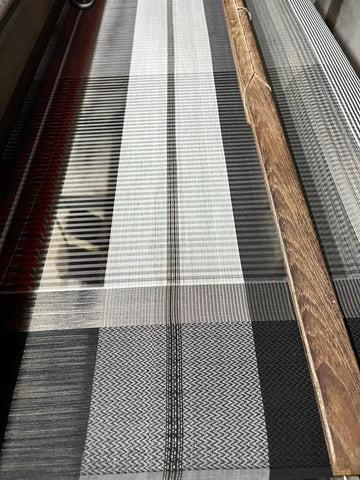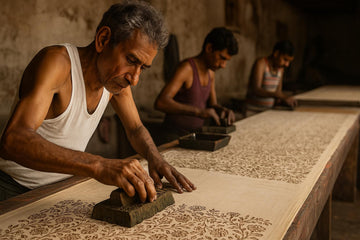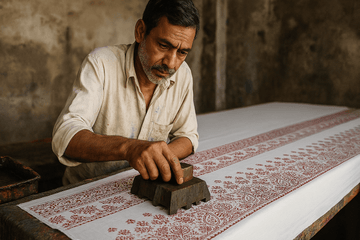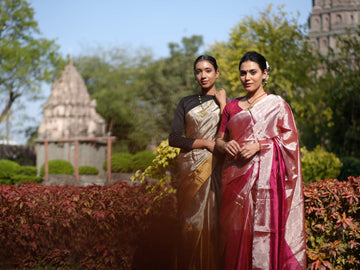Most Popular Handloom Cultures of India - Etched in timeless traditions and history
by Rahul Patwa on Jan 19, 2023

Handlooms are an integral part of India's cultural heritage, reflecting the diverse traditions and customs of the country's different regions. Among the most renowned handlooms of India are Chanderi, Benarasi, Maheshwari, Kanjeveram, Patola, Paithanis, and Ikkat. Each of these handlooms has its own unique characteristics, making them an important part of India's rich textile history.
Maheshwari handlooms, from the town of Maheshwar in Madhya Pradesh, are known for their lightweight, airy fabrics that are typically made from silk, cotton and zari. The fabrics are often adorned with geometric patterns, and are typically dyed in natural colors. Maheshwari handlooms have been used for centuries to create saris and other traditional garments, and are particularly popular among women in Central India.
One of the most notable figures associated with the Maheshwari handlooms is Maharani Ahilyabai Holkar, who ruled the Maratha kingdom of Indore in the late 18th century. She recognized the importance of the handloom industry and established several handloom centers in Maheshwar, providing financial support and encouragement for the weavers. She also established schools and orphanages to provide education and support for the children of weavers.
Chanderi handlooms, from the town of Chanderi in Madhya Pradesh, are known for their fine, lightweight fabrics that are traditionally made from a blend of silk and cotton. The fabrics are often adorned with intricate designs, including geometric patterns and delicate floral motifs. Chanderi handlooms have been used for centuries to create saris and other traditional garments, and are particularly popular among women in North India.
Benarasi handlooms, from the city of Varanasi in Uttar Pradesh, are renowned for their luxurious silk fabrics that are adorned with delicate gold and silver threadwork. The fabrics are often used to create sarees, dupattas, and shawls, and are considered to be among the most elegant and sophisticated handlooms in India. Benarasi handlooms have been a symbol of prestige and opulence throughout India's history, and are often worn by women on special occasions.
Kanjeveram handlooms, from the city of Kanchipuram in Tamil Nadu, are known for their heavy silk fabrics that are often adorned with intricate designs and motifs. The fabrics are used to create sarees and other traditional garments, and are particularly popular among women in South India. Kanjeveram handlooms have been an important part of India's textile tradition for centuries, and are considered to be among the most beautiful and elegant handlooms in India.
Patola handlooms, from the state of Gujarat, are known for their double ikat technique fabrics that are considered to be one of the most complex and difficult textile weaving techniques. The fabrics are often adorned with geometric patterns, and are typically dyed in bright colors. Patola handlooms have been used for centuries to create saris and other traditional garments, and are particularly popular among women in Western India.
Paithani handlooms, from the town of Paithan in Maharashtra, are known for their silk fabrics that are adorned with intricate designs and motifs. The fabrics are used to create sarees and other traditional garments, and are particularly popular among women in Western India. Paithani handlooms have been an important part of India's textile tradition for centuries, and are considered to be among the most beautiful and elegant handlooms in India.
Ikkat handlooms, from various parts of India, are known for their tie-dye technique fabrics that are adorned with intricate designs and motifs. The fabrics are used to create saris and other traditional garments, and are particularly popular among women in rural and tribal areas. Ikkat handlooms have been an important part of India's textile tradition for centuries, and are considered to be among the most unique and beautiful handlooms in India.
Kota Doria: These sarees are from Kota, Rajasthan, and are known for their lightweight and airy fabrics made from cotton or silk. They are characterized by their small, square checks or "doria" pattern, which gives them their name.
Sambalpuri: These sarees are from the Sambalpur district of Odisha and are known for their intricate "Ikat" weave and bold geometric patterns. They are made from cotton or silk and are known for their durability and comfort.
Pochampally: These sarees are from the Pochampally village in Telangana and are known for their geometric ikat patterns. They are made from cotton or silk and are known for their durability and comfort.
Baluchari: These sarees are from the Baluchar village in West Bengal and are known for their intricate, fine silk fabrics and narrating themes from Hindu epics and stories.
Chikankari: These sarees are from Lucknow, Uttar Pradesh, and are known for their delicate, white embroidery on cotton or muslin fabrics. They are considered to be among the most elegant and sophisticated handlooms in India.
All these sarees have their own unique characteristics and are an important part of India's rich textile heritage. Each of these sarees are carefully crafted by skilled weavers using traditional techniques passed down through generations. These sarees are not just a piece of clothing but a reflection of the cultural and traditional values of the regions they belong to.
The process of making a handloom saree
The process of making a handloom saree begins with the preparation of the yarn. The yarn is dyed in the desired colors and then wound onto the loom. The weaver then sets up the loom, threading the warp and weft threads in a specific pattern to create the desired design. The weaver then begins to weave the fabric, using hand-operated pedals and levers to control the movement of the threads.
Once the fabric is complete, it is washed and dried, and then ironed to remove any wrinkles. The fabric is then cut and sewn into a sari, with the border and Pallu added. The final product is a beautiful, handcrafted sari that is a true work of art.
Support the handlooms of India - Support the artisans
In recent years, the handloom industry has faced many challenges, including competition from machine-made textiles and a decline in demand for traditional handloom products. However, there has been a renewed interest in handlooms in recent years, with many people recognizing the unique beauty and craftsmanship of these traditional textiles. Many organizations and government bodies are also working to promote and support the handloom industry, providing training and financial support for weavers and increasing awareness about the importance of handlooms.
In conclusion, handlooms are an integral part of India's cultural heritage and at Maahishmati Sarees we are inspired by this timeless legacy to keep it going and make it bigger. Welcome to our world and let's keep this rich and diverse legacy of Indian handlooms going. Jai Hind!
#6YardsofElegance #Royal #Timeless #BringSareesBack #SareeNotSorry





